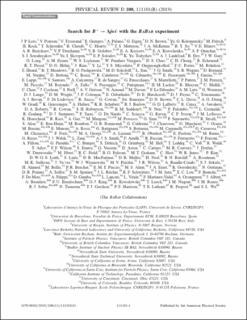| dc.contributor.author | Lees, JP | |
| dc.contributor.author | Poireau, V. | |
| dc.contributor.author | Tisserand, V. | |
| dc.contributor.author | Grauges, E. | |
| dc.contributor.author | Palano, A. | |
| dc.contributor.author | Eigen, Gerald | |
| dc.contributor.author | Brown, DN | |
| dc.contributor.author | Kolomensky, Yu. G. | |
| dc.contributor.author | Fritsch, M. | |
| dc.contributor.author | Koch, H. | |
| dc.contributor.author | Schroeder, T. | |
| dc.contributor.author | Cheaib, R | |
| dc.contributor.author | Hearty, C. | |
| dc.contributor.author | Mattison, T. S. | |
| dc.contributor.author | McKenna, J. A. | |
| dc.contributor.author | So, RY | |
| dc.contributor.author | Blinov, V. E. | |
| dc.contributor.author | Buzykaev, AR | |
| dc.contributor.author | Druzhinin, V. P. | |
| dc.contributor.author | Golubev, V. B. | |
| dc.contributor.author | Kozyrev, Evgeny A. | |
| dc.contributor.author | Kravchenko, EA | |
| dc.contributor.author | Onuchin, A. P. | |
| dc.contributor.author | Serednyakov, S. I. | |
| dc.contributor.author | Skovpen, Yu. I. | |
| dc.contributor.author | Solodov, E. P. | |
| dc.contributor.author | Todyshev, K. Yu. | |
| dc.contributor.author | Lankford, A. J. | |
| dc.contributor.author | Dey, B | |
| dc.contributor.author | Gary, J. W. | |
| dc.contributor.author | Long, O. | |
| dc.contributor.author | Eisner, A. M. | |
| dc.contributor.author | Lockman, W. S. | |
| dc.contributor.author | Panduro Vazquez, W | |
| dc.contributor.author | Chao, DS | |
| dc.contributor.author | Cheng, CH | |
| dc.contributor.author | Echenard, B | |
| dc.contributor.author | Flood, K. T. | |
| dc.contributor.author | Hitlin, D. G. | |
| dc.contributor.author | Kim, J. | |
| dc.contributor.author | Li, Y. | |
| dc.contributor.author | Miyashita, TS | |
| dc.contributor.author | Ongmongkolkul, P | |
| dc.contributor.author | Porter, F. C. | |
| dc.contributor.author | Röhrken, M | |
| dc.contributor.author | Huard, Z | |
| dc.contributor.author | Meadows, B. T. | |
| dc.contributor.author | Pushpawela, BG | |
| dc.contributor.author | Sokoloff, M. D. | |
| dc.contributor.author | Sun, L | |
| dc.date.accessioned | 2021-04-22T10:46:13Z | |
| dc.date.available | 2021-04-22T10:46:13Z | |
| dc.date.created | 2020-02-06T02:45:03Z | |
| dc.date.issued | 2019 | |
| dc.Published | Physical Review D. 2019, 100 (11), . | |
| dc.identifier.issn | 2470-0010 | |
| dc.identifier.uri | https://hdl.handle.net/11250/2739100 | |
| dc.description.abstract | A search for the rare flavor-changing neutral current process B − → Λ ¯ p ν ¯ ν using data from the BABAR experiment has been performed. A total of 424 fb − 1 of e + e − collision data collected at the center-of-mass energy of the Υ ( 4 S ) resonance is used in this study, corresponding to a sample of ( 471 ± 3 ) × 10 6 B ¯ B pairs. Signal B − → Λ ¯ p ν ¯ ν candidates are identified by first fully reconstructing a B + decay in one of many possible exclusive decays to hadronic final states, then examining detector activity that is not associated with this reconstructed B + decay for evidence of a signal B − → Λ ¯ p ν ¯ ν decay. The data yield is found to be consistent with the expected background contribution under a null signal hypothesis, resulting in an upper limit of B ( B − → Λ ¯ p ν ¯ ν ) < 3.0 × 10 − 5 at the 90% confidence level. | en_US |
| dc.language.iso | eng | en_US |
| dc.publisher | American Physical Society | en_US |
| dc.rights | Navngivelse 4.0 Internasjonal | * |
| dc.rights.uri | http://creativecommons.org/licenses/by/4.0/deed.no | * |
| dc.title | Search for B−→Λ¯pν¯ν with the BaBar experiment | en_US |
| dc.type | Journal article | en_US |
| dc.type | Peer reviewed | en_US |
| dc.description.version | publishedVersion | en_US |
| dc.source.articlenumber | 111101(R) | en_US |
| cristin.ispublished | true | |
| cristin.fulltext | original | |
| cristin.fulltext | original | |
| cristin.qualitycode | 1 | |
| dc.identifier.doi | https://doi.org/10.1103/PhysRevD.100.111101 | |
| dc.identifier.cristin | 1791446 | |
| dc.source.journal | Physical Review D | en_US |
| dc.source.40 | 100 | |
| dc.source.14 | 11 | |
| dc.identifier.citation | Physical Review D. 2019, 100, 111101(R) | en_US |
| dc.source.volume | 100 | en_US |

